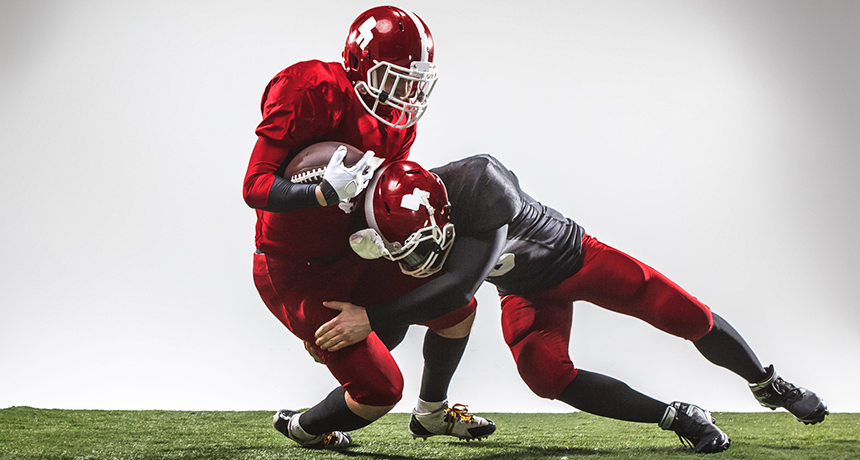Football and hockey don’t necessarily doom players’ brains to serious damage
Tests of former pro athletes showed their brains appear better than even the players had expected

Football tackles can leave players sore — and sometimes suffering a concussion. But new data from professional athletes suggest that not all players sustain serious long-term brain damage from years of play.
master1305/iStockphoto
A career of hard knocks to the head will not necessarily leave pro athletes with serious, permanent brain damage. That’s the take-home message from a small study. It included pro athletes who had taken a lot of hard hits during their career — including to the head. The findings now challenge what had been suggested by other studies that had autopsied the brains of former college and pro football players.
The new data come from tests of 21 retired athletes. All had been football players with New York’s Buffalo Bills or hockey players with the Buffalo Sabres.
Each player allowed researchers to extensively scan his brain. The players also took behavioral tests. From these, the scientists turned up no signs of early dementia or unusual rates of mental decline. Both can point to a brain disease known as CTE. That’s short for chronic traumatic encephalopathy (KRON-ik Traw-MAA-tik En-seff-uh-LAH-puh-thee). Today, doctors diagnose CTE only by looking at a brain after someone has died.
For the new study, University of Buffalo researchers gave the athletes a battery of clinical tests. These measured brain function and mental health. Other tests probed such health features as diet, obesity and history of drug or alcohol use. Findings from these men were then compared to those from 21 noncontact athletes (such as runners and cyclists).
The former hockey and football players had expected bad news. They “were pretty much their own worst critics,” says Barry Willer, an author of the new research. This psychiatrist studies traumatic brain injury at the University of Buffalo in New York. The athletes had believed their brains to be impaired, he notes.
In fact, the new tests did not find high rates of problems with memory, solving problems, decision making or being able to plan things. The researchers also found no evidence of declines in the men’s attention, language and spatial abilities. Based on these tests, none of the former football and hockey players appeared to have early-onset dementia.
The good news “was a big surprise to us — and a big surprise to the athletes,” Willer says. The results are in line with several earlier studies of living athletes. This includes one published last year. It, too, found no major problems in the mental abilities of 33 retired hockey pros.
The authors shared their latest findings in a series of papers. All were published August 7 in the Journal of Head Trauma Rehabilitation.
Not all athletes were totally fine
Eight of the 21 contact athletes appeared to show mild mental impairment. So did three of the 21 other athletes. Such mental problems could hint that dementia will develop. But the difference in rates between the two groups may not be due solely to more head knocks in the hockey and football players. Education, IQ and a man’s weight also could have contributed to some of the apparent difference. As such, the authors say they cannot firmly link rates of mild mental decline seen to which sport a man had played.
Brain scans told a similar story. Several types of magnetic-resonance imaging, or MRI, turned up no big differences. They showed no big differences in brain anatomy. They also didn’t show big links to behaviors in athletes with a history of contact versus noncontact sports. Still, seven of the non-contact athletes showed microbleeds. Scientists have linked these tiny ruptures in brain blood vessels with poorer brain function. The same microbleeds showed up in only two of football and hockey players.
Carrie Esopenko works at Rutgers University in Newark, N.J. She’s trained as a cognitive neuroscientist and a psychologist. Studies of the living, as here, “are exactly what we really need,” she says. Such studies “are really going to help us understand what’s going on in these lives.”
The new study also may ease some recent concerns. Last year, researchers had reported in JAMA that 110 of 111 autopsies turned up CTE in the brains of former pro football players. Those brains had been donated by family members who had suspected something was amiss. However, such concerns and symptoms may mean this sample represented the sickest of former players.
Indeed, notes neurologist Rodolfo Savica: “People who do not have symptoms do not donate their brains.” Savica works at the Mayo Clinic in Rochester, Minn., and was not involved in either study.
Athletes who took part in the new study were in their mid-50s. So they would have been relatively young for a dementia diagnosis. Still, based on earlier reports of brain damage, the researchers had expected to find some signs of dementia in these football and hockey players.
To better understand the prevalence of CTE, though, more research will be needed. Researchers want to see a larger sample of athletes who suffer blows to the head as well as those who don’t. “There’s a lot more that we don’t know than we do know,” says coauthor John Leddy of the University of Buffalo’s Concussion Management Clinic.







